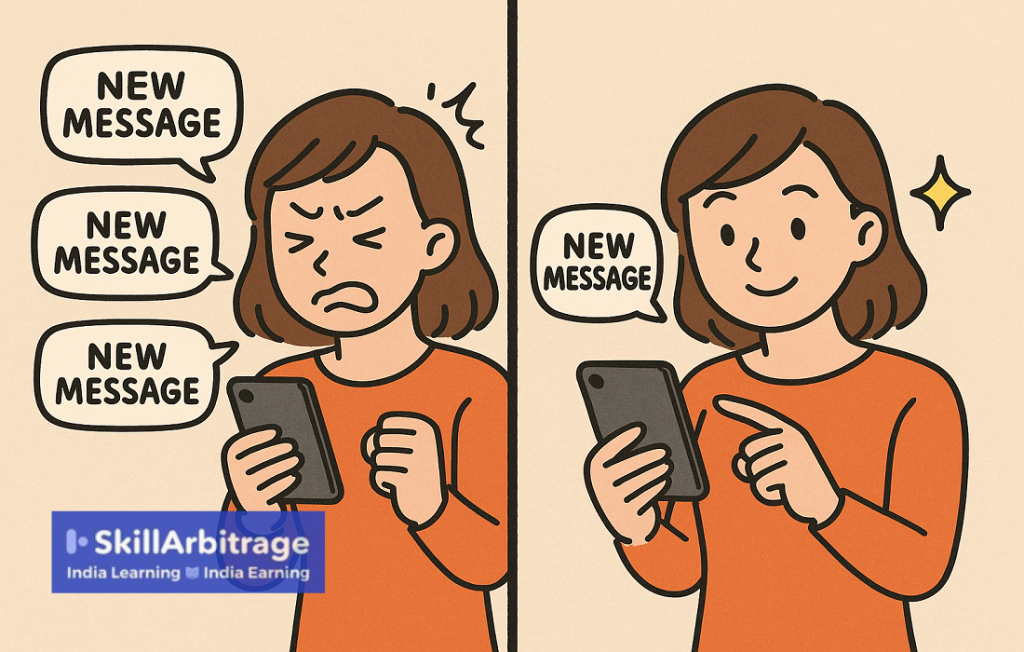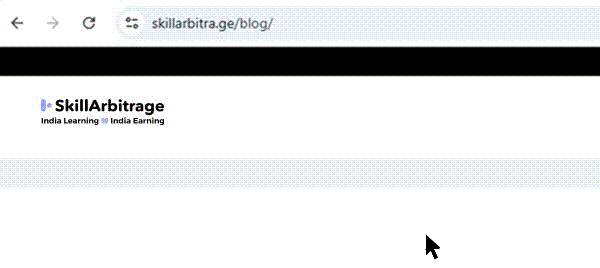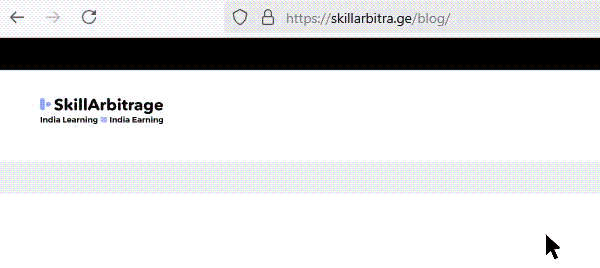This blog will show you exactly how to follow up with leads in a way that keeps the conversation going without sounding pushy so that you actually close the deal.
Table of Contents
Introduction
A few days ago, one of my students texted me saying, “Sir, I messaged a lead 4 times. They saw it and didn’t reply. Should I follow up again or just leave it?”
I told him to stop sending generic reminders and instead offer something useful. He sent a fifth message offering a quick free competitor analysis (because budget seemed like the hidden issue). This finally got him on a call the next day, and the deal closed within 48 hours.
But that is when I realised that this was not just his problem; most salespeople also don’t know how to follow up with a lead correctly.
You also must have faced the same problem. You have a lead who showed interest. Maybe they asked for details, maybe they even said they’d get back. But now? Nothing. Silence.
And you end up sitting there thinking, “What if I follow up and they get annoyed?” But let me tell you the truth: Following up is not annoying, but following up badly is. But if you don’t follow up at all, you lose the sale by default.
According to a study, 80% of sales require 5 follow-ups, but 44% of salespeople give up after just one. That’s a lot of money left on the table.
Basically, if you follow up wrongly, people get annoyed, and if you don’t even follow up, you lose the sale anyway. So what could you do? Simple – Improve the way you follow up.
Your goal should not be to send more messages. Your goal should be to send the right messages at the right time with the right tone.
Therefore, in this blog, I’ll give you a step-by-step system to follow up without being annoying so that you stay on top of your leads’ minds without getting ghosted (hence close the deal).
But first, the most important part you should know is why most follow-ups get ignored.
Why do most follow-ups get ignored?
If your follow-ups are also getting ignored, or you get very low conversions after follow-ups, this is the part you should keep the most focus on. Because chances are that you’re making at least one of these mistakes without even realizing it.
And no, it’s not that your lead is rude. Or that they’re not interested. Don’t let such excuses come into your head. Because if that were true, then the top salesmen in your company or competitors wouldn’t have higher conversion rates than you.
The truth is that most of the time, the problem is with how the message was written, when it was sent, or what it said (or didn’t say).
So, before you send your next “just checking in” follow-up, go through this list and see if you’re doing any of these. Because even one of them can kill your chances of getting a reply:
- You say something like “Did you see my last message?” or “Just checking in.” This doesn’t look like a good follow-up, instead, it looks like a desperate attempt to chase them. And, the truth is, leads don’t respond well to desperation.
- You send follow-ups that don’t really offer anything helpful. There’s no new information, no insight, nothing that makes them stop and think. Most people are busy, so if there’s no value in your email, they’ll skip it without a second thought.
- You follow up either too early or way too late. You need to do it at the perfect time because too early will make them feel annoyed, while too late will make them not even remember who you are. When the timing is off, the follow-up just doesn’t work.
- You keep saying the same thing again and again in every follow-up. It’s just the same message written in different words. If there’s nothing new, they’ll stop reading because they already know what you’re going to say.
- You make the message all about yourself. You say things like “I wanted to follow up” or “I just wanted to check in”. But leads don’t care about what you want, instead they care about what’s in it for them.
- You don’t handle the real reason they’re not replying. You need to figure out if they’re unsure about the price, the timing, or whether it’s even worth it. If you don’t address those objections, the lead will just stay quiet.
- You don’t really have a follow-up plan. You just send messages whenever you remember or feel like it. There’s no structure, no goal, no building up, and that’s why it doesn’t lead anywhere. You need a proper, well-thought-out plan.
So now you know why most follow-ups get ignored. And if you found yourself doing even one of these, that’s actually a good thing because it means now you can fix it.
I hope you understood that the problem was never the follow-up itself. The problem was the way it was being done. Now, let’s fix that.
Let me show you exactly how to follow up in the right way without sounding desperate, without getting ignored, and without guessing what to say next.
A step-by-step method to follow up with leads without being annoying
Now, before we start, let me make one thing clear.
This is not some random list of follow-up tips. This is an actual system you can use in your sales chats, emails, or calls. And that too, in a step-by-step manner so you always know what to say, when to say it, and how to say it without sounding pushy.
Just follow each step one by one, and by the end, you’ll have a solid follow-up flow that keeps leads warm and makes sure you close the sale like a master. Let’s begin.
Step 1: Use the core principle behind good follow-ups
The first step you need to take is to understand what a follow-up even needs to be like. I mean the core principle behind good follow-ups. Because, in my experience, most salespeople think it’s just about sending messages like:
- “Just checking in…”
- “Any update?”
- “Are you still interested?”
This is exactly where they go wrong and it’s the reason their follow-ups get ignored. Just read that again from the lead’s point of view. Why should they reply to this? It doesn’t offer anything new. It doesn’t help them. It doesn’t move the conversation forward.
Understood my point? If yes, then here’s what you need to do instead (important):
Before you send any follow-up, simply ask yourself a question – “What value am I adding in this message that wasn’t in the last one?”
If you don’t have an answer, stop immediately because you’re about to send a message that adds nothing, and that’s a waste of both your time and theirs. There’s an almost negligible chance of getting a reply or closing the deal. Here’s what to do step-by-step:
- Find a thing you can give them that’ll be useful
You need to give a value in the message else there’s no reason for the lead to spend their time reading or thinking about your message.
You need to give them something that helps them, solves a tiny part of their problem, or moves them closer to their goal.
And it doesn’t need to be a big thing. Even a small win will be enough to create interest. Think about what you could offer as per your business. There’s no strict, hard-and-fast rule, but here is what works for most businesses:
- A quick tip based on what they told you earlier
- A short case study or result from someone like them
- A bonus or incentive they didn’t know about
- A helpful resource (PDF, blog, checklist, video)
- A smart question that makes them think
Here’s an example so that you understand even better: Suppose you run a business that sells website design services to small businesses. And a lead had earlier shown interest but stopped replying.
You could follow up by sharing a quick 2-minute video breakdown of a competitor’s website, pointing out why it converts better and one small change the lead can make on their own site right now.
- Make your follow-up lead with that value
This is where you will mess up next. You will give value, but the main focus of your message will become the follow-up, and the value will be added with a link or a tip after the follow-up, like it’s some afterthought.
A big mistake. Your value will not do its job if it works like an extra. Your value needs to be the reason you are reaching out. After picking what to share, make that the focus of your message.
The value should hit them right away and not be buried in the last line. That’s what will make your follow-up feel different and not like every other sales follow-up message.
For example: You start your message with, “I had a quick look at your homepage and noticed one simple fix that could increase leads. Want me to show you what I’d change and why it works for your competitor?”
- Ask for the reply
Until now, your lead will be happy with the value and be happy that he gave you their time. It’s time you came to the main agenda of your follow-up, which is to ask for the reply.
You need to give them a clear next step. A simple question. Something that makes it easy for them to respond without thinking too much. Because if you don’t ask, they won’t act even if they liked what you said.
There’s no fixed rule when it comes to this. So, simply ask them for the action you want them to take in a simple and short manner. For example:
You can end your message with, “Also, would like to remind you about the offer that we gave you. Are you still interested or do you have any doubts?”
One more thing, Indian leads respond better when your follow-ups feel personal. If possible, mention something local or relatable in your message. For example:
“Hi Rahul, I passed your showroom in Bandra today which reminded me about your project. Here’s a quick idea I thought might help.”
This small touch builds genuine rapport and increases your chances of getting a reply. I hope you understood where most people mess up. Also I hope you got an idea of how your follow-ups should be structured. This must remain common to all follow-ups, no matter what.
But as we all know, it takes at least 5 follow-ups for 80% of sales, so it’s very important that you plan those follow-ups in advance. You cannot send the same thing 5 times.
You need to send a flow of follow-ups that are designed in a way that it slowly persuades the lead to become a buyer.
Step 2: Build a 5-message follow-up plan
This is where you need to stop doing random follow-ups and start doing follow-ups like a pro. Because if you’re writing follow-ups one at a time, whenever you feel like it, you’ll always sound inconsistent.
And worse, you’ll eventually start repeating yourself or sounding desperate, and that’s when the lead tunes out. That’s why you need to plan your entire follow-up sequence in advance.
Not 1 message. A full 5-message plan. Each message should have a specific purpose, so it doesn’t feel like you’re just chasing them. This follow-up sequence will help you nurture the lead properly. Here’s how your sequence can look:
- Follow-up 1
This will be the first follow-up you will be sending so it needs to be simple. Because it could be the case that the lead forgot about your offer or procrastinated.
So in this follow-up, you just need to check if they got the original message and, if needed, offer any help. Here’s how it could sound like:
“Hey Ramesh, just wanted to check if you had a chance to go through the offer I sent. Happy to help if you have questions!”
- Follow-up 2
By now, you’ve already followed up once, so the lead knows who you are. So if they have not replied, it’s time you build trust so that they know you are real. And the best way to do that is with proof. Show them that your offer actually works.
You can share a quick result, a testimonial, or a short story of someone who got the outcome they’re looking for. Here’s how this message could sound:
“Last week, one of our clients used this exact solution and closed 3 large deals in just 5 days. Just thought you’d like to know how it’s working for others, too.”
- Follow-up 3
By now, the lead clearly knows that what you offer actually works. They’ve seen your offer and testimonials, too. So if they’re still not replying, it might be because they are procrastinating, hence, they don’t feel any urgency.
That’s why this follow-up should add a little pressure. Not in a pushy way, but by giving them a reason to act quickly. You can do this by offering a bonus, a time-sensitive opportunity, or something they’ll miss out on if they wait too long.
Here’s how it could sound – “Hey, just a heads-up! We’re offering 2 bonus sessions for people who join before the end of this week. Let me know if I should hold one for you.”
- Follow-up 4
At this point, if the lead still hasn’t replied, it’s time to find out where they actually stand or what the problem is. This follow-up will not be about selling instead, it’ll be about qualifying.
Maybe they’re not interested anymore. Maybe the timing’s off. Or maybe they’re still thinking but haven’t decided anything. So now, you must ask a direct question to get clarity. This saves time for both of you. Here’s how it could sound:
“Just checking. Are you still exploring solutions for [pain point], or has this taken a back seat for now? Totally okay either way, I just want to respect your time.”
- Follow-up 5
This is your final message in the sequence. And by now, if they haven’t replied, you should stop chasing them, or else it will spoil even the 1% chance you have of them coming back themselves sometime in the future. You have to exit politely and leave the door open.
This follow-up is not going to be about getting a reply. It’ll be about ending the thread professionally while still giving them the option to come back when they’re ready. Here’s how it could sound:
“Hey [Name], I haven’t heard back, so I’ll assume it’s not the right time. If anything changes, feel free to reach out. I’ll be here to help when you’re ready.”
And that’s how you create a follow-up sequence that actually leads somewhere instead of being just a bunch of random messages
.
Because once you know what you’ll say in each message, you won’t repeat yourself or sound desperate. Every message will have a clear purpose, and that will give you the highest probability of closing.
But here’s the problem – Even a perfect 5-message plan will fail if the timing is wrong.
If you send all five messages in one single day, it’ll feel like spam, and the lead will either ignore you or get irritated. And if you send them once every month, they’ll forget who you are by the second message.
That’s why now you need to get the timing right. When to send, how long to wait, and how to space your follow-ups so they feel natural, not annoying. Let’s fix that next.
Step 3: Time it out smartly
Following up daily will make you look desperate, and following up with a long delay will make you forget. In both cases, you don’t make a sale. That’s why it’s important to follow up at the right time and with proper gaps.
You need to give the leads enough space to think, process, and respond. So, here’s the exact framework on how to time out your follow-up sequence to get the best results:
- The first follow-up, which was about a simple reminder, should be sent after 24 hours, and then you should wait for another 24-48 hours before going with the second follow-up.
- After the second follow-up, which was about building trust through proof, you should wait for around 48 more hours before sending the next one.
You’ve already shared value, so now you need to give them space to think about it or maybe discuss it with someone on their side.
- After the third follow-up, which added urgency, you should wait for around 3 more days to send the fourth follow-up. At this point, the lead knows what’s on the table and that they need to act quicker.
Now we will only give them a small enough time to decide if they want to take action or not.
- After the fourth follow-up, where you asked a qualifying question, wait for 4 to 5 days before sending the final message. Now it’s their turn to respond.
You’ve done your part, so give them some space. It shows patience, and it keeps you from sounding pushy. Don’t try sending anything else, it will immediately spoil any chance you get.
The timing framework I just gave works perfectly for emails or longer messages. But if you’re using WhatsApp, Instagram DMs, or similar platforms, then you need to shorten these gaps to around 12–24 hours between each message.
And if you’re in a slow-paced industry (like real estate or B2B deals), you might need longer gaps. There’s no fixed rule for everyone, so use the above framework as a starting point and then adjust it according to how quickly your leads usually respond.
So I hope it’s clear to you how you need to follow up to make sure you don’t sound annoying and, at the same time, have the highest chance of closing the lead.
But how about showing you a full-blown example? That too, with all 5 follow-ups so that you can understand better how they go and how they’re written.
A full example to help you understand it better
Let’s put everything we’ve covered into one full example so you can see how the entire follow-up system works from start to finish.
Suppose you run a business that sells website design services to small business owners. And one day, a lead fills out your contact form asking for pricing. You reply with a detailed email explaining the offer. But after that? Nothing. No reply. Silence.
Now, here’s how the 5-message follow-up system would look in this case (all sent via email):
- Follow-up 1 (after 24 hours)
This is your first follow-up. Keep it simple. Your only job is to make sure they saw the original message. Here’s the email –
Subject: Just checking if you saw this
Hi Rahul,
Just wanted to check if you had a chance to go through the email I sent yesterday regarding the website redesign.
Let me know if you have any questions or need help understanding anything. Happy to help.
– [Your Name]
- Follow-up 2 (24-48 hours after the first one)
Now it’s time to build trust. Share a short result that shows what your work has done for others. Here’s the email –
Subject: Quick result I thought you’d like to see
Hi Rahul,
Just thought I’d share something real quick — last month, we redesigned the website for a small café here in Mumbai. Within 3 weeks, they were getting 3x more online orders.
I figured it might be useful to see how this has helped others in a similar space. Let me know if you’d like me to send over a quick breakdown.
– [Your Name]
- Follow-up 3 (48 hours after the second one)
Now, you should add urgency. Give them a reason to act sooner without sounding desperate. Here’s the email –
Subject: Quick heads-up! Bonus sessions this week
Hi Rahul,
Just wanted to give you a quick heads-up. We’re offering 2 bonus sessions for new clients who sign up this week: one for content writing and one for SEO setup.
It’s just something we’re doing to help businesses get faster results from the new site. Let me know if I should hold a slot for you.
– [Your Name]
- Follow-up 4 (3 days after the third one)
Now, you shift the tone. Stop selling. Your goal is just to get clarity now. Here’s the email –
Subject: Quick question
Hi Rahul,
Just checking. Are you still exploring website redesign options, or has this taken a back seat for now?
Totally okay either way. I just want to make sure I’m not bothering you if now’s not the right time.
– [Your Name]
- Follow-up 5 (4-5 days after the fourth one)
This is your final message. Stay calm, respectful, and leave the door open. Here’s the email –
Subject: I’ll pause here for now
Hi Rahul,
Since I haven’t heard back, I’ll assume the timing isn’t right at the moment. No worries at all. If things change in the future and you’d like to revisit the website project, feel free to reach out. I’ll be here if you need me.
– [Your Name]
This is what a complete follow-up system looks like. Every message has a purpose. Nothing feels random. And the tone stays helpful from start to finish.
What if you’re using WhatsApp or Instagram?
If most of your leads talk to you via WhatsApp or Instagram DMs, the email style above won’t fully work because these platforms have different rules. Here’s what you should change:
- Keep it short: Messages under 50 words. People scroll fast, so say things quickly.
- Use visuals: Screenshots, short videos, or even voice notes can make your messages stand out.
- Be casual: WhatsApp and Instagram aren’t formal. Keep it natural and friendly.
Here’s an example of how your second follow-up could sound on WhatsApp:
“Hey Rahul, quick one. I just made this short 30-sec video showing how we redesigned a client’s site and tripled their leads. Check it out when you have a moment. Want to have a quick call about yours?”
And one more thing, never say stuff like “I saw you read my last message” or “You saw my previous message.” This comes across passive-aggressive and makes them uncomfortable.
How to automate your follow-ups (to save hours)
The method I just gave you works perfectly but when you start getting dozens or hundreds of leads, manually sending each follow-up becomes impossible.
That’s when you need automation tools. Here are the best ones to easily automate this 5-message sequence without losing personalization:
- For email follow-ups: Use Zoho CRM or HubSpot CRM. Both let you schedule a series of follow-ups, personalize each email, and send them automatically at exactly the right intervals. Set once, then forget.
- For WhatsApp follow-ups: Use Wati or Interakt. Both tools help you schedule automated WhatsApp messages at specific timings. Your leads get personalized, timely follow-ups without you manually typing each one.
Using automation tools isn’t mandatory, but if you want to grow your business and handle more leads without wasting hours every day, it quickly becomes a necessity.
Conclusion
Most salespeople don’t lose deals because they follow up. They lose deals because they follow up the wrong way. You’ve now seen exactly how to follow up with leads in a way that builds trust, shows value, and never feels desperate.
Now, go ahead and plan your sequence, space it out correctly, add core value in each message, and show respect when it’s time to back off. Go put this into action. Your future sales are waiting.
Frequently Asked Questions
- What if the lead replies saying “Not interested” after I follow up?
That’s your clear sign to stop, but how you respond still matters. Don’t try to convince them. Just thank them for their time, leave the door open, and move on. Why? Because sometimes people come back after 1–2 months. And they only do that if you didn’t act needy when they said no. One polite reply keeps the relationship clean.
- What if I mostly use WhatsApp or Instagram DMs instead of email?
The same method still applies. But here, the timing becomes even more important. People check messages faster, but also forget faster. So keep follow-ups shorter and more spaced out, around 48 hours to 3 days is best. Also, never say, “You saw my message,” even if they did. It feels passive-aggressive. Just restart the conversation with a new angle.
- What if I don’t know what “value” to give in each follow-up?
Think small. Value doesn’t mean a free product or a big discount. It can be a helpful tip, a new offer they didn’t know, a customer success story, or even just a smart question. If you know their pain point, you’ll always have something to say. You’re not trying to impress. You’re trying to help.
- How do I know the lead is worth following up at all?
Ask yourself: Did they show interest, ask for details, or show buying intent earlier? If yes, they’re worth it. But if it was a cold DM you sent, and they never engaged even once, don’t waste too much time there. Follow-ups work best when there’s at least some initial interest.
- How many follow-ups are “too many”?
More than five is usually too much if they’ve been ignoring you consistently. But if they’ve been engaging (even with one-word replies or showing interest earlier), you can go beyond five as long as each message adds something new. The rule is simple: if it still feels like value, it’s okay. If it starts to feel like begging, stop.
- Do I need to worry about data privacy when following up via WhatsApp or email?
Yes, absolutely. Always comply with India’s Digital Personal Data Protection Act, 2023, especially when sending follow-ups via WhatsApp or email. This simply means you should never message someone without their clear consent, and always respect their preferences if they ask you to stop messaging.







 Allow notifications
Allow notifications
